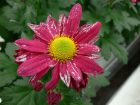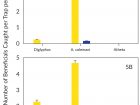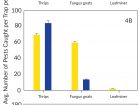
Features
Biocontrols
Inputs
Thrips Control: Making the Case for Mass Trapping
For the best results, tape and cards should be placed just above the crop canopy – this may mean periodically moving the traps to maintain optimal positioning.
April 12, 2017 By Dr. Sarah Jandricic
 Petal streaking caused by thrips feeding, which makes the plant unsellable.
Petal streaking caused by thrips feeding, which makes the plant unsellable. May 2017 – In Ontario, we continue to struggle with control of western flower thrips. Even those growers religiously using preventive, mite-based biocontrol programs can suddenly find themselves throwing out a significant portion of their crop due to visible damage.
Why does this happen? It’s hard to know for sure sometimes. But things like higher than usual numbers of thrips eggs in imported cuttings, hot dry weather (like we had this summer), or problems with mite sachets (such as quality issues or improper placement) can all lead to high thrips populations.
What is clear is that more than just predatory mites are needed to keep your biocontrol program consistent and stable. And one of the easiest and cheapest ways to do this is with mass trapping.
Mass trapping often consists of large sticky cards or long ribbons of sticky tape that attract and trap pests. Sticky traps can remove large numbers of adult thrips by intercepting them whenever they decide to fly – whether that’s when they first venture into your greenhouse, when they’re disturbed, or when they just decide to check out some plants on the next bench.
I can already hear some of you saying “But tape is messy and my workers hate it.” I get it – I do. But I’m still going to tell you that mass trapping is worth every bit of annoyance it causes in terms of its contribution to thrips management. Remember, each thrips female can lay over 300 eggs her lifetime1, so removing any number of adults lightens the load on your biocontrol program.
Several studies demonstrate that using mass trapping effectively reduces the number of thrips in horticultural crops. One of the best examples is in strawberries produced under plastic. Here, the number of thrips averaged 6/flower with the existing IPM program (predatory mites, spinosad sprays), but dropped to <2/flower when sticky tape was added2. This corresponded to far lower thrips damage on fruit and increased grower returns.
My own research this past summer showed the staggering numbers of thrips mass trapping can remove from floriculture greenhouses in Ontario.
In trials testing different colors and patterns of tape in commercial mum crops (both potted and cut;, the best treatment caught an average of > 150 thrips/2 feet of tape every week (see Fig. 4C). In just our small trial plots, we caught over 10,000 thrips from June to August.
Now, If we calculate this out to see how many thrips we could have removed over the summer if we’d put tape down all the post rows in a whole greenhouse compartment, we get over one million adult thrips. This is one million fewer thrips reproducing in your crop; one million fewer thrips causing feeding damage; and one million fewer thrips overwhelming your predatory mites.
It just makes sense that if you’re going to set up mass trapping, you might as well get the best bang for your buck. So which is the trap type is the most attractive to thrips?
We often hear that blue traps a) catch as many (or more!) thrips than yellow traps, and that b) blue traps will catch fewer flying biological control agents, helping preserve your bio programs for other pests. And now there’s new, patterned blue tape on the market that purports to catch even more thrips. But is any of this actually true in practice? Given that the scientific literature is all over the place on this one, I thought it was important to test this in Ontario greenhouses. Along with trials last summer, I tested this in preliminary trials this spring.
Test plots were set up in a commercial potted chrysanthemum operation and thrips catches on different traps were tracked over time. Studies indicate the specific hue of a trap (i.e. wavelength of light it reflects) is critical in thrips attraction, so it was important to test traps from multiple suppliers.
We also looked at beneficials trapped, as this greenhouse has active banker plants of A. colemani and regularly releases Diglyphus and Atheta.
For two out of the three trap products, yellow caught more thrips – a LOT more thrips (Figs. 4A & C). Catches averaged from more than two-times more thrips on yellow vs. blue, to up to eight-times more thrips. However, with a third manufacturer, blue was actually better than yellow (Fig. 4B), but only slightly. Patterned blue tape wasn’t any better than regular blue tape in our tests (Fig. 4C).
Although yellow cards from multiple manufacturers caught more beneficials on average (Fig. 5A & B), the numbers were very low (<5 per card/week), which I doubt would have any negative impact on pest control outcomes. However, catches in warmer months might be more significant, and we need to look other natural enemies (e.g. whitefly parasitoids, Delphastus, etc.) before we have the full picture.
Figure 4. Average number of pest insects caught on yellow or blue traps. A.) Large yellow cards (40 x 25 cm) from Company “B” vs. large blue cards from Company “C” in preliminary tests in Spring 2017. B. Large yellow cards from Company “B” vs. large blue cards from Company “B” in preliminary tests in Spring 2017. C) Strips of yellow tape (40 x 25 cm) vs. plain blue tape vs. patterned blue tape, all from Company “A” tested in Summer 2016; results were confirmed in two other chrysanthemum greenhouses. There were 12-24 replicates (cards) for each trap type.
Figure 5. Average number of beneficial insects caught on large yellow trap cards versus blue trap cards (preliminary test conducted in Spring 2017). A) Yellow from Company “B” and blue from Company “C” were compared . B. Yellow from Company “B” and blue from Company “B” were compared. There were 12 cards of each colour.
THE BOTTOM LINE
Mass trapping has the ability to be a useful tool in IPM programs, removing thousands of thrips per week from your greenhouse. As for the “best” trap type, this question is far from answered. Considering the incredible variation in sticky trap manufacturing processes (glue, hue, trap type, size, etc.) a more in-depth trial is needed this summer to better control for these variables. Until we know more, plain yellow tape or cards may be your best bet (at least in terms of consistency) to reduce thrips. Yellow also has the benefit of trapping a lot more of other pests, like fungus gnats (Fig. 4) and whitefly.
However, it’s impossible to say that even our “final” results at the end of this summer will necessarily hold true across all crops, at all times of year, across all trap manufacturers. So, it’s a good idea to test more than one type of mass trapping device side-by-side in a quick comparison in your own facility.
For the best results, tape and cards should be placed just above the crop canopy– this may mean periodically moving the traps to maintain optimal positioning. Putting out enough traps is also a key factor in mass trapping. As an example, 120 large-size cards (four per bench) in a 15,000 sq.ft. zone (i.e. eight large cards/1000 sq.ft) has been a successful density in some commercial mum operations.
For more information on mass trapping – including trap plants and how pheromone lures can improve thrips catches even more – look for an upcoming article in Greenhouse Canada by Dr. Rose Buitenhuis.
I would like to thank the greenhouses , their staff, and the consultants that participated in this study.
References:
- Loomans, van Lenteren, Tommasini, Maini and Riudavets. 1995. Biological control of thrips pests. Wageningen Agricultural University Papers 95.1 201 pp.
- Sampson, C. and Kirk, W.D.J. 2013. Can Mass Trapping Reduce Thrips Damage and Is It Economically Viable? Management of the Western Flower Thrips in Strawberry. PLOS ONE:
http://dx.doi.org/10.1371/journal.pone.0080787
Dr. Sarah Jandricic is the OMAFRA greenhouse floriculture IPM specialist.
Print this page



